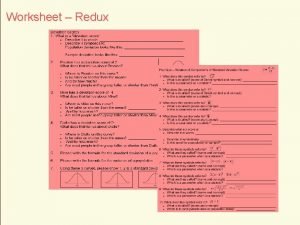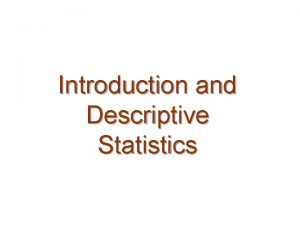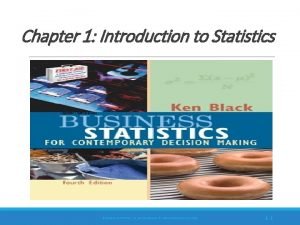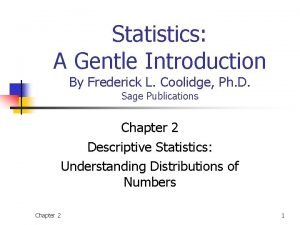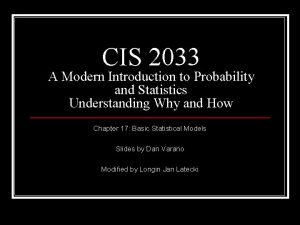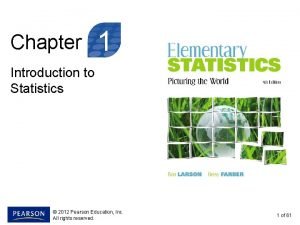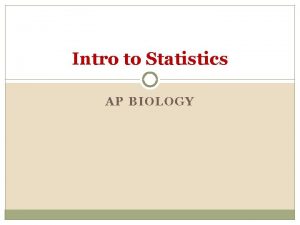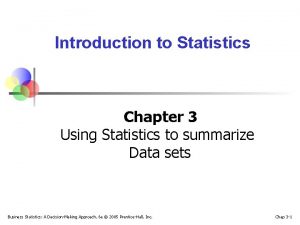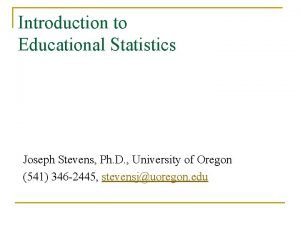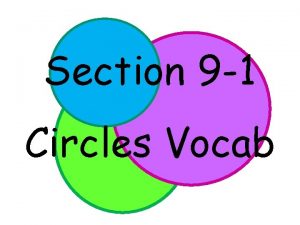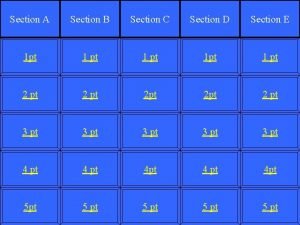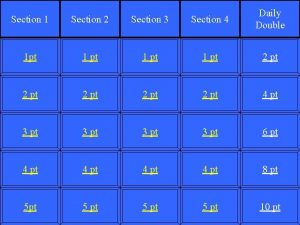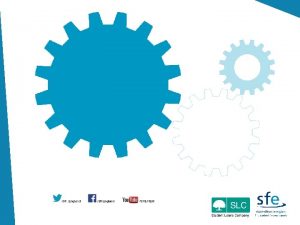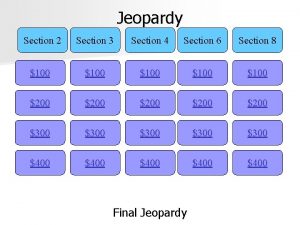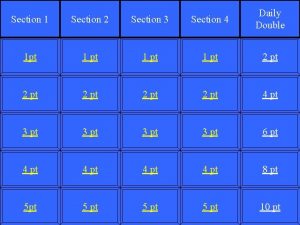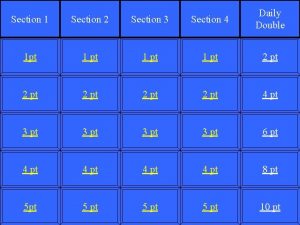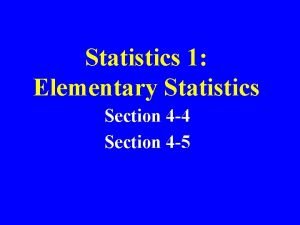SECTION 3 1 STATISTICS INTRODUCTION TO STATISTICS Statistics


















- Slides: 18

SECTION 3. 1 STATISTICS

INTRODUCTION TO STATISTICS • Statistics is the science of making effective use of numerical data relating to groups of individuals or experiments.

POPULATION AND SAMPLE • A population is a collection or set of individuals, objects, or events whose properties, called variables, are to be analyzed. A sample is a subset of that population.

PARAMETER AND STATISTIC • A value that represents the entire population is called a parameter. • A value that is a measure of the sample is called a statistic.

EXAMPLE 1 • Determine if the numerical value is a parameter or statistic. A) The population of Virginia is 7, 650, 000 B) In a sample of US House Holds, 62 % had internet service.

SOLUTION TO EXAMPLE 1 • Solution: A) The population of Virginia is 7, 650, 000: Parameter B) In a sample of US House Holds, 62 % had internet service: Statistic

SAMPLING • To obtain a simple random sample the goal is to get a sample that accurately represents the population that is being studied.

CATEGORICAL AND NUMERICAL DATA • Types of variables 1) Numerical (Quantitative) Variables: Data in the form of numbers. 2) Categorical (Qualitative) Variables: Data in the form of non-numerical information.

EXAMPLE 2 • Describe each example as either categorical data or numerical data. A) Number of residents in Fairfax County B) A phone number C) The name of a political party D) The number of votes needed to win the election.

SOLUTION TO EXAMPLE 2 A) Number of residents in Fairfax County: Numeric Variable B) A phone number: Categorical Variable (The data is a number, but the number does represent any quantity. The value is just randomly assigned) C) The name of a political party: Categorical Variable D) The number of votes needed to win the election: Numeric Variable

EXAMPLE 3 • 27 SUV’s were randomly selected from a Ford Plant in Detroit. 2. 1% were found to have defective airbags. A) What is the population? B) What is the sample? C) What is the statistic?

SOLUTION TO EXAMPLE 3 • 27 SUV’s were randomly selected from a Ford Plant in Detroit. 2. 1% were found to have defective airbags. A) What is the population? All the SUVs made by the Ford plant in Detroit B) What is the sample? 27 SUVs C) What is the statistic? 2. 1% were found to have defective airbags.

EXAMPLE 4 • A study of Math 114 students were taken at the end of Spring 2018. A sample of 30 found 78% had a positive experience in the course. A) What is the population? B) What is the sample? C) What is the statistic?

SOLUTION TO EXAMPLE 4 • A study of Math 114 students were taken at the end of Spring 2018. A sample of 30 found 78% had a positive experience in the course. A) What is the population? All students who took Math 114 in Spring 2018 A) What is the sample? 30 students A) What is the statistic? 78% had a positive experience in the course.

EXAMPLE 5 • Which of the following is a parameter and which is a statistic? A) 99% RU students have a cell phone B) The yearly payroll of the payers on the Washington Capitals is $32, 000. C) 82% of adults surveyed admit to drug use.

SOLUTION TO EXAMPLE 5 • Which of the following is a parameter and which is a statistic? A) 99% RU students have a cell phone parameter A) The yearly payroll of the payers on the Washington Capitals is $32, 000. parameter A) 82% of adults surveyed admit to drug use. statistic

EXAMPLE 6 • Identify each as categorical data or numerical data A) The time of the woman’s 200 m run from the London Olympic B) The eye color of students in this class C) The social security number of the students in this class D) The zip code of all the post offices in New River Valley area.

SOLUTION TO EXAMPLE 6 • Identify each as categorical data or numerical data A) The time of the woman’s 200 m run from the London Olympic numerical A) The eye color of students in this class categorical A) The social security number of the students in this class. categorical B) The zip code of all the post offices in New River Valley area. categorical
 Introduction to statistics what is statistics
Introduction to statistics what is statistics Introduction to statistics worksheet
Introduction to statistics worksheet Introduction to statistics and some basic concepts
Introduction to statistics and some basic concepts Introduction to descriptive statistics
Introduction to descriptive statistics Business statistics chapter 1
Business statistics chapter 1 Introduction to bayesian statistics
Introduction to bayesian statistics Introduction to elementary statistics
Introduction to elementary statistics Statistics a gentle introduction
Statistics a gentle introduction A modern introduction to probability and statistics
A modern introduction to probability and statistics Chapter 1 introduction to statistics
Chapter 1 introduction to statistics Biological statistics
Biological statistics Introduction to statistics chapter 3 answers
Introduction to statistics chapter 3 answers Introduction to educational statistics
Introduction to educational statistics Cross sectional view
Cross sectional view What is a revolved section
What is a revolved section Cutting plane line symbol
Cutting plane line symbol Section 2 describing energy (continued)
Section 2 describing energy (continued) Section quick check chapter 10 section 1 meiosis answer key
Section quick check chapter 10 section 1 meiosis answer key Section 9 topic 1 introduction to circles
Section 9 topic 1 introduction to circles

